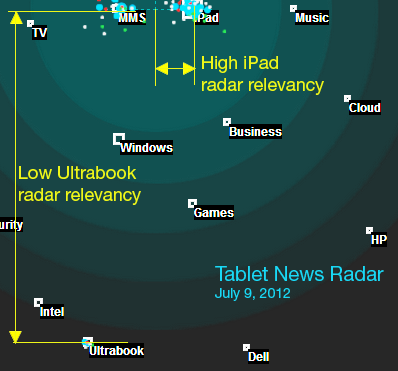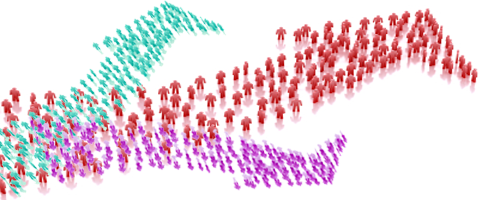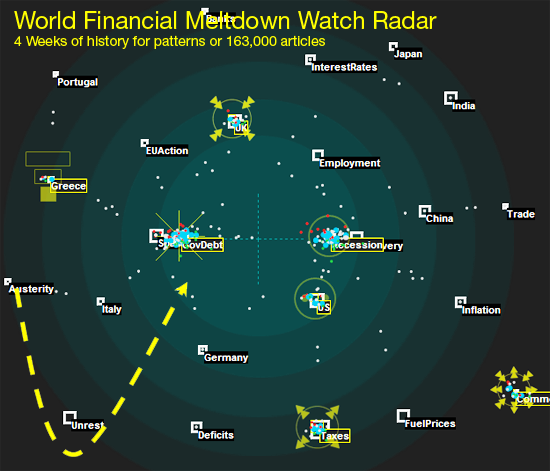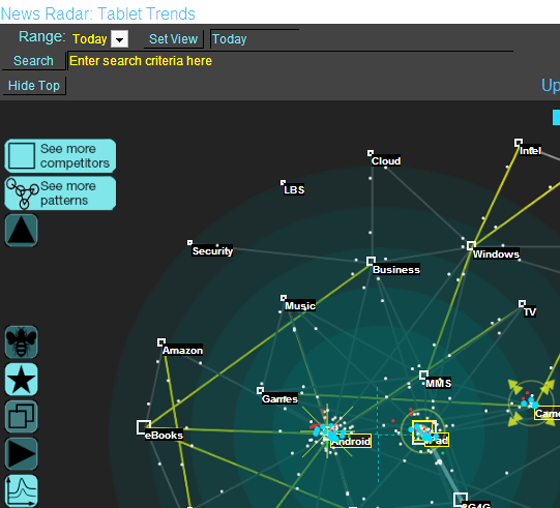News Patterns has been tracking and patterning the news of the 2012 US presidential election for several years. Millions of articles were collected and subjected to our pattern discovery algorithms. A very powerful aspect of our news patterning is that patterns in the news often anticipate or closely correlate to actual voter behaviors. This past Tuesday, all the patterning came down to the actual voting. Here is what we saw and would have recommended to both Romney and Obama campaigns:
1) The 2012 News Radar correctly displayed that the election was about Obama versus Romney, showing both of these news topics as central and anchors in News Radar.
2) Romney campaign succeeded in making the logical topics of Economy and Jobs as central election topics. Nevertheless, the Obama campaign trumped this campaign battle success with its own news topics.
3) The Obama campaign was successful in creating the emotional "war on women" as a central campaign topic.
4) Super storm Sandy gave millions of voters an opportunity to see Obama as the leader in times of need and citizen support. Governor Chris Christie made this a super topic by reinforcing bipartisan imagery with Obama just before the election.
5) Obama campaign gathered additional support with Education and Fix Washington topics. Romney campaign contested the Fix Washington topic.
6) Romney used Spending as one of his campaign topics, yet Obama team muted this topic with associations of "do nothing Congress."
7) It was a great surprise to News Patterns analysis team that Romney campaign did not make better use of Fuel Cost and Food Cost topics, both of which were essentially irrelevant on election day.
8) The Health Care-Tax topic, created by the Supreme Court was also not used by the Romney campaign.
9) It is also surprising that Team Romney did not use Security/Arab Spring topics to their advantage.
If there was a meta pattern that points to the Obama success in the 2012 election is was this: the hard facts of Economy and Jobs as targeted by team Romney were trumped by US electorate wanting emotional comfort, including the idea that their choice from 2008 was a good man and leader. To the undecided, still on the fence in the previous week, the imagery of Obama the leader in time of crisis over Hurricane Sandy swayed them in the direction of Obama. There was no time for a Romney recovery. The Romney campaign never built up a reservoir of emotional attraction to Romney the man and leader, nor an emotional distaste for Obama the man and leader.
1) The 2012 News Radar correctly displayed that the election was about Obama versus Romney, showing both of these news topics as central and anchors in News Radar.
2) Romney campaign succeeded in making the logical topics of Economy and Jobs as central election topics. Nevertheless, the Obama campaign trumped this campaign battle success with its own news topics.
3) The Obama campaign was successful in creating the emotional "war on women" as a central campaign topic.
4) Super storm Sandy gave millions of voters an opportunity to see Obama as the leader in times of need and citizen support. Governor Chris Christie made this a super topic by reinforcing bipartisan imagery with Obama just before the election.
5) Obama campaign gathered additional support with Education and Fix Washington topics. Romney campaign contested the Fix Washington topic.
6) Romney used Spending as one of his campaign topics, yet Obama team muted this topic with associations of "do nothing Congress."
7) It was a great surprise to News Patterns analysis team that Romney campaign did not make better use of Fuel Cost and Food Cost topics, both of which were essentially irrelevant on election day.
8) The Health Care-Tax topic, created by the Supreme Court was also not used by the Romney campaign.
9) It is also surprising that Team Romney did not use Security/Arab Spring topics to their advantage.
If there was a meta pattern that points to the Obama success in the 2012 election is was this: the hard facts of Economy and Jobs as targeted by team Romney were trumped by US electorate wanting emotional comfort, including the idea that their choice from 2008 was a good man and leader. To the undecided, still on the fence in the previous week, the imagery of Obama the leader in time of crisis over Hurricane Sandy swayed them in the direction of Obama. There was no time for a Romney recovery. The Romney campaign never built up a reservoir of emotional attraction to Romney the man and leader, nor an emotional distaste for Obama the man and leader.












